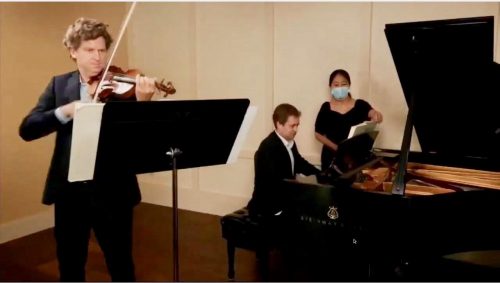 United States Beethoven: James Ehnes (violin), Andrew Armstrong (piano), presented virtually by Aspen Music Festival, streaming from Center for Chamber Music, Seattle, 12.7.2020. (HS)
United States Beethoven: James Ehnes (violin), Andrew Armstrong (piano), presented virtually by Aspen Music Festival, streaming from Center for Chamber Music, Seattle, 12.7.2020. (HS)

Beethoven – Violin Sonata No.1 in D major; Adagio from Violin Sonata No.6 in A major; Violin Sonata No.5 in F major, ‘Spring’
Two of Beethoven’s more uplifting sonatas for violin and piano found soloist James Ehnes and pianist Andrew Armstrong looking and sounding like they were truly enjoying themselves in the first Sunday concert of the Aspen Music Festival’s series of virtual performances.
Chalk up some of that to the sheer joy of making live music after a long drought as the pandemic limits most musicians to recording shoot-from-the-hip videos, streaming short pieces from their homes, or participating in celebratory events like the festival’s salute to music director Robert Spano the previous weekend.
Ehnes and Armstrong recently completed a three-year compilation on three albums of all nine Beethoven violin sonatas. Before the pandemic canceled the Aspen season, they had been scheduled to get into the full cycle this summer. Audiences can’t share Harris Hall with them, but listeners at least got a performance made specially for Aspen, with excellent sound, fluid camera work and musicians who did everything they could to connect with a remote audience they could not see.
Playing in Seattle’s Center for Chamber Music, Ehnes and Armstrong launched into the hour-long recital with a winning combination of vigor and deftness right from the first phrases of Sonata No.1. Melodic phrases and crunching chords struck just the right level of contrast, and recurring scale-like runs sparkled every time they came around. The pace never flagged, even in the sweet Andante at the center of the piece, and the Rondo Allegro topped things off with plenty of juicy moments.
Having played these sonatas together in recital for several years, Ehnes and Armstrong were in sync and breathing together on every phrase. The music flowed effortlessly, especially in the Adagio from Violin Sonata No.6, which served as a sort of gentle intermezzo between Sonata No.1 and Sonata No.5 ‘Spring’ which concluded the concert.
The lilt in ‘Spring’s’ opening Allegro felt entirely natural, and the development cast just enough of a shadow to make the return of the first themes feel fresh. The middle movements contrasted the lyrical weight of the Adagio with the zip of the Scherzo, setting up a good-natured romp through the Allegro non troppo finale.
Playing of this stature might be just the ticket as we enter the second half of a year fraught with so much disquieting news.
Harvey Steiman
For more about the Seattle Chamber Music Society click here.
